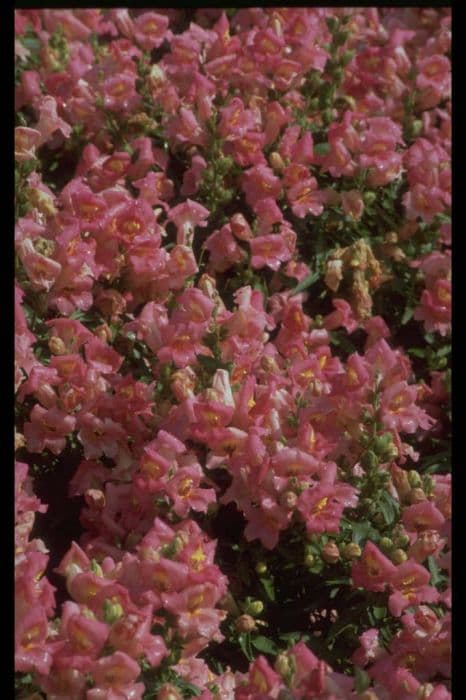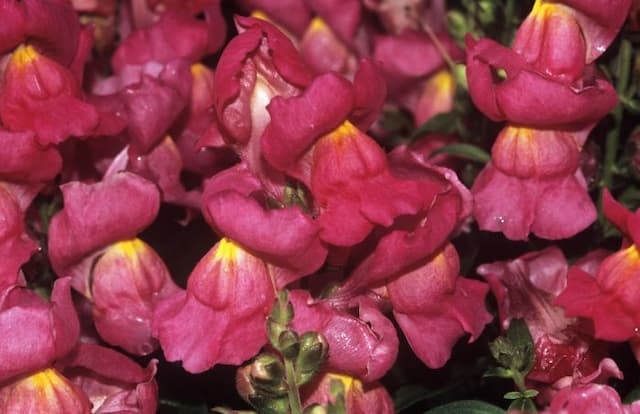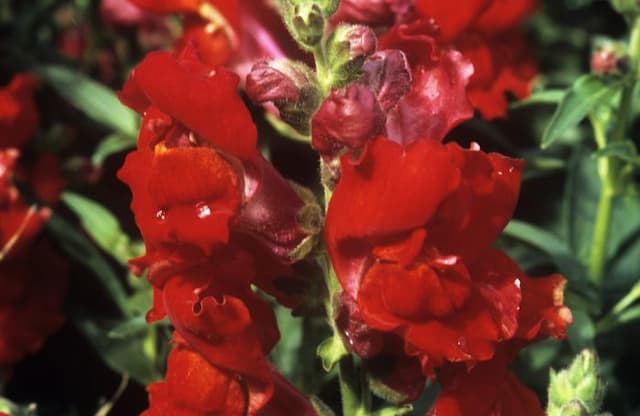Beardtongue Penstemon 'Mother of Pearl'

ABOUT
Penstemon 'Mother of Pearl' is a charming perennial known for its distinctive flowers and foliage. It is admired for its abundant flowering habit, usually beginning in late spring and extending into early summer, and often blooming intermittently until fall. This plant showcases elongated tubular flowers that have a graceful, bell-like shape and are a soft shimmering color reminiscent of the inside of a seashell. This pearl-like hue is a mix of pale pink with a subtle lavender blush, sometimes with a pearly sheen that catches the light. The throat of these flowers often features delicate streaks or striations, which can be a slightly darker shade, providing a lovely contrast and depth to the overall floral display. The foliage of Penstemon 'Mother of Pearl' consists of lance-shaped leaves that are narrow and pointed. The leaves are arranged in a dense manner along the stems, providing a lush, green backdrop that makes the pale, iridescent blooms stand out even more. In some instances, the foliage may have a slight blue-green tint, which further enhances the visual appeal of this plant. Moreover, this Penstemon variety forms an upright, clump-forming habit with the stems and leaves creating a bushy appearance. The combination of its colorful flowers and attractive foliage makes it a favorite choice for garden borders, rock gardens, and as an accent in mixed perennial beds.
About this plant
 Names
NamesFamily
Plantaginaceae
Synonyms
Beardtongue, Mother of Pearl Penstemon
Common names
Penstemon 'Mother of Pearl'
 Toxicity
ToxicityTo humans
Penstemon 'Mother of Pearl', commonly known as beardtongue, is not known to be toxic to humans. There are no well-documented cases of poisoning from ingesting this plant, and it is generally not considered harmful. However, as with any non-food plant, individual allergic reactions or sensitivities could potentially occur, so it is advisable to avoid consuming this plant unless it is known to be safe for you.
To pets
Beardtongue, the common name of Penstemon 'Mother of Pearl', is not listed as a toxic plant to pets by major animal poison control resources. It is generally considered non-toxic to both cats and dogs. No significant evidence suggests that pets would suffer from poisoning if they ingest this plant. However, ingestion of non-food plants can sometimes cause mild gastrointestinal upset in pets, so it's still a good practice to prevent pets from consuming plants not intended for their diet.
 Characteristics
CharacteristicsLife cycle
Perennials
Foliage type
Semi-deciduous
Color of leaves
Green
Flower color
Pink
Height
2 feet (60 cm)
Spread
2 feet (60 cm)
Plant type
Herb
Hardiness zones
Varies
Native area
North America
Benefits
 General Benefits
General Benefits- Attractive Flowers - Produces delicate 'Mother of Pearl' pinkish-white blooms that add visual appeal to gardens.
- Pollinator Friendly - Flowers attract bees, hummingbirds, and butterflies, supporting local biodiversity.
- Drought Tolerance - Once established, it has good resistance to drought, reducing the need for frequent watering.
- Low Maintenance - Requires minimal care once established, making it suitable for beginner gardeners.
- Cold Hardy - Can withstand cold temperatures, making it suitable for growing in cooler climates.
- Long Blooming - Has a lengthy flowering period from late spring to early fall, providing a long-lasting display of color.
- Versatility - Suitable for borders, rock gardens, and as a background plant in mixed beds.
- Deer Resistance - Generally resistant to browsing by deer, which helps to reduce garden damage.
- Soil Adaptability - Able to thrive in a range of soil types, as long as they are well-draining.
- Structural Habitat - Offers shelter and nesting sites for wildlife within its foliage and stems.
 Medical Properties
Medical PropertiesThis plant is not used for medical purposes.
 Air-purifying Qualities
Air-purifying QualitiesThis plant is not specifically known for air purifying qualities.
 Other Uses
Other Uses- Artistic inspiration: Penstemon 'Mother of Pearl' can serve as a subject for botanical art, offering a range of subtle colors and shapes for artists to capture.
- Fauna support: The plant can provide nectar for pollinators like bees and hummingbirds, playing a role in the support of local wildlife ecosystems.
- Photography: Due to its attractive blooms, Penstemon 'Mother of Pearl' is an excellent candidate for photography, making it a favorite for garden photographers.
- Educational tool: It can be used in educational settings to teach about plant growth, pollination, and the importance of native flora in garden settings.
- Thematic gardening: Penstemon 'Mother of Pearl' can be included in a pearl or gemstone-themed garden design due to its name and delicate appearance.
- Culinary decoration: The flowers can be used as a garnish for culinary dishes, although they are not known to be edible.
- Color dye: Historically, some Penstemon species have been used to create natural dyes, and this variety may also have potential for this use.
- Seasonal celebrations: As it blooms in spring to summer, it can be used in seasonal floral arrangements for events such as Easter or as part of a summer solstice celebration.
- Wedding decorations: The elegant flowers of Penstemon 'Mother of Pearl' can be part of wedding bouquets or venue decorations, offering a natural and delicate touch.
- Drought-tolerant landscaping: In areas with water restrictions or those seeking to conserve water, this plant can be a valuable addition due to its drought tolerance.
Interesting Facts
 Feng Shui
Feng ShuiThe Beardtongue is not used in Feng Shui practice.
 Zodiac Sign Compitability
Zodiac Sign CompitabilityThe Beardtongue is not used in astrology practice.
 Plant Symbolism
Plant Symbolism- Charm and Grace: The 'Mother of Pearl' variety of Penstemon boasts delicate pearl-like buds before they bloom, symbolizing the effortless charm and grace found in nature.
- Strength and Resilience: Penstemons are known for their hardiness and ability to thrive in challenging conditions, representing an individual's inner strength and resilience.
- Diversity and Adaptability: With over 250 species, Penstemons illustrate the rich diversity of the plant kingdom and its adaptability across different environments.
- Longevity and Endurance: Penstemon 'Mother of Pearl' has a long blooming period, signifying longevity and the endurance to withstand the test of time.
- Balance and Harmony: The plant's growth habit of upright stems with balanced foliage and flowers can symbolize the quest for balance and harmony in one's life.
- Beauty in Simplicity: The understated elegance of its blooms reminds us of the beauty that can be found in simplicity and the importance of appreciating subtle wonders.
 Water
WaterBeardtongues, like the Penstemon 'Mother of Pearl', should be watered deeply but infrequently, as they prefer well-drained soil and do not tolerate wet feet. Typically, watering once weekly with about one to two gallons per plant is sufficient during the growing season. During hot, dry spells, you might need to water them twice a week. In the winter, reduce watering significantly, only supplementing if there's been no rainfall for an extended period. It’s important to avoid overhead watering to reduce the risk of foliar diseases.
 Light
LightBeardtongues thrive in full sun to partial shade conditions. The ideal spot for Penstemon 'Mother of Pearl' is in a location that receives at least six to eight hours of direct sunlight daily. Light afternoon shade can be beneficial in hotter climates to prevent scorching. The plant will bloom most profusely in full sun, so choose a south or west-facing position if possible.
 Temperature
TemperatureBeardtongues prefer moderate temperatures and can tolerate a range that is typical of many temperate climates. Penstemon 'Mother of Pearl' can survive minimum temperatures down to about -20°F, while maximum temperatures should not exceed 90°F for prolonged periods. The ideal temperature range for this plant is between 60°F and 75°F. Proper mulching can help it to survive colder winters.
 Pruning
PruningPruning beardtongues helps to encourage bushier growth and more flowers. For Penstemon 'Mother of Pearl', prune in early spring by cutting back the plant to just above the ground, leaving only three inches to stimulate new growth. Deadheading, or removing spent flowers, can also promote a second bloom. Pruning is typically done annually, but deadheading can be done throughout the blooming season as needed.
 Cleaning
CleaningAs needed
 Soil
SoilFor Beardtongue 'Mother of Pearl', the best soil mix is well-draining and fertile, with added compost or organic matter. A sandy loam to loamy soil is ideal. The soil pH should be slightly acidic to neutral, ranging from 6.0 to 7.0 for optimal growth.
 Repotting
RepottingBeardtongue 'Mother of Pearl' does not require frequent repotting. It should be repotted once it outgrows its container, typically every 2 to 3 years, to refresh the soil and provide more growing space.
 Humidity & Misting
Humidity & MistingBeardtongue 'Mother of Pearl' is tolerant of a wide range of humidity levels but prefers moderate conditions. It does not require high humidity environments and can adapt to the typical atmospheric humidity found outdoors.
 Suitable locations
Suitable locationsIndoor
Place in bright, indirect light and ensure good air circulation.
Outdoor
Plant in full sun to partial shade and protect from strong winds.
Hardiness zone
5-9 USDA
 Life cycle
Life cyclePenstemon 'Mother of Pearl', commonly known as beardtongue, begins its life cycle with seed germination, typically occurring in spring when soil temperatures warm up. After germination, seedlings establish themselves, developing a root system and foliage through the vegetative growth stage. This perennial then enters a phase of rapid growth and expansion, leading to the development of flowering stems in late spring to early summer. The flowers, which are appealing to pollinators such as bees and hummingbirds, blossom and subsequently produce seeds, ensuring the continuation of the species. Following the flowering and seed-setting period, Penstemon 'Mother of Pearl' may enter a state of dormancy in late fall or winter, depending on the climate. The plant resumes its growth cycle when favorable conditions return, and if properly cared for, it can live for several years, flowering annually.
 Propogation
PropogationPropogation time
Spring to Summer
Propogation: The Penstemon 'Mother of Pearl', commonly known as beardtongue, is most commonly propagated using stem cuttings. This method is usually best done in late spring or early summer when the plant's growth is vigorous. To propagate, select a healthy, non-flowering stem and cut a piece about 4 to 6 inches long using sharp, clean shears. Remove the lower leaves, leaving only a couple at the top, and dip the cut end into a rooting hormone powder. Then, insert the cutting into moistened potting soil or a mixture of peat and perlite. Cover it with a plastic bag to retain humidity, and place it in a warm, bright spot out of direct sunlight. Roots typically develop in a few weeks, after which the cutting can be gradually acclimated to less humid conditions and eventually transplanted outside.









